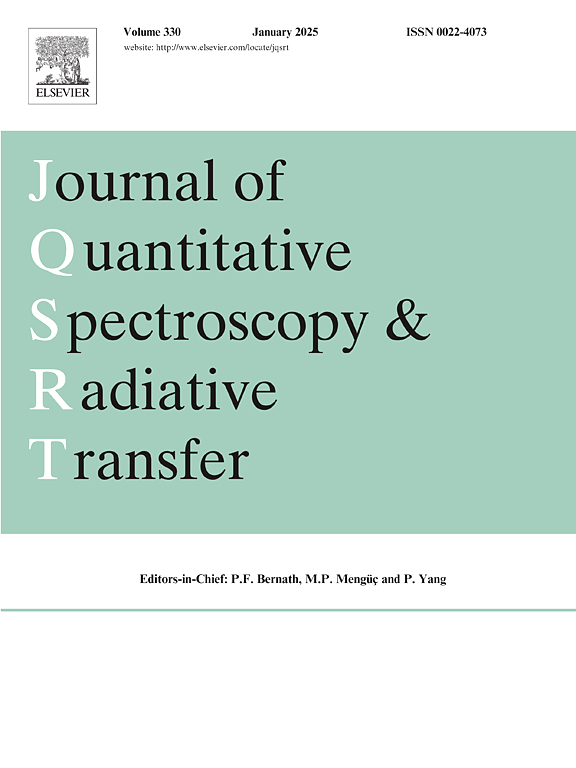偶极子源附近任意截面极化解耦圆柱体的条件t矩阵法
IF 1.9
3区 物理与天体物理
Q2 OPTICS
Journal of Quantitative Spectroscopy & Radiative Transfer
Pub Date : 2025-06-23
DOI:10.1016/j.jqsrt.2025.109572
引用次数: 0
摘要
在偶极子等三维有限源照射下,无限长介电圆柱体的2.5维散射解涉及线源型场的线性叠加。对于任意方向的电偶极子源或磁偶极子源激励,问题简化为与电或磁线源激励的二维耦合问题,其径向和纵向光谱依赖关系分别为圆柱形和斜平面。另一方面,对于任意截面的圆柱形散射体,T矩阵法计算激发源各谱分量的性质是病态的。此外,当激发源靠近散射体时,增加圆柱次谐波数并不能提高解的精度。本文研究了一种通过将场解耦为TM/TE分量来简化分析的等折射散射体,以解决2.5维散射情况下T矩阵法固有困难的三个改进关键:无限连续kz谱的有效数值积分,每个激励分量的条件良好的t矩阵公式,以及在近似源情况下t矩阵公式中入射场系数的平面波频谱内容的截断。采用遗传算法对改进后的参数进行调整。我们的结果与优化参数,以边界积分公式和三维求解器为基准,突出了我们的方法在处理不同几何形状和激励条件下的2.5-D散射问题的有效性。本文章由计算机程序翻译,如有差异,请以英文原文为准。
Well-conditioned T-matrix method for a polarization-decoupling cylinder with arbitrary cross-section near a dipole source
The 2.5-dimensional (2.5-D) scattering solutions of an infinitely long dielectric cylindrical body illuminated by a 3-D finite source, such as a dipole, involve a linear superposition of line source-type fields. For electric or magnetic dipole source excitation oriented in any direction, the problem reduces to a two-dimensional coupled problem with excitation of the electric or magnetic line sources, whose radial and longitudinal spectral dependences are cylindrical and obliquely planar respectively. On the other hand, the nature of the T matrix method for each spectral component of the excitation source is ill-conditioned for cylindrical scatterers with arbitrary cross-section. Besides, when the excitation source is close to the scatterer, increasing the number of cylindrical harmonics does not improve the accuracy of the solutions. In this paper, an isorefractive scatterer that simplifies the analysis by decoupling the fields into TM/TE components is examined to address three improvement keys of the inherent difficulties in the T matrix method for 2.5-D scattering case: Efficient numerical integration of the infinite continuous spectrum, well-conditioned T-Matrix formulation for each excitation component, and truncation of the plane wave spectral content of the incident field coefficients for the T-Matrix formulation in the proximate source case. Genetic algorithms were used to tune the parameters resulting from the proposed improvements. Our results with optimized parameters, benchmarked against boundary integral formulations and a 3-D solver, highlight the efficacy of our approach in handling 2.5-D scattering problems with different geometries and excitation conditions.
求助全文
通过发布文献求助,成功后即可免费获取论文全文。
去求助
来源期刊
CiteScore
5.30
自引率
21.70%
发文量
273
审稿时长
58 days
期刊介绍:
Papers with the following subject areas are suitable for publication in the Journal of Quantitative Spectroscopy and Radiative Transfer:
- Theoretical and experimental aspects of the spectra of atoms, molecules, ions, and plasmas.
- Spectral lineshape studies including models and computational algorithms.
- Atmospheric spectroscopy.
- Theoretical and experimental aspects of light scattering.
- Application of light scattering in particle characterization and remote sensing.
- Application of light scattering in biological sciences and medicine.
- Radiative transfer in absorbing, emitting, and scattering media.
- Radiative transfer in stochastic media.

 求助内容:
求助内容: 应助结果提醒方式:
应助结果提醒方式:


